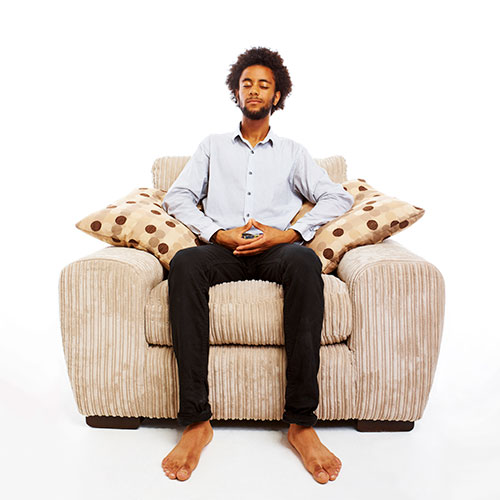A simple, effective approach to self-care and stress-relief
With the news contributing to growing stress levels, there’s an increased focus on self-care, with people seeking solace in better sleep, exercise, therapy or massage.
Yoga instructor Amanda Bell-Tardif (Personal Fitness Trainer ’09) turns to meditation as part of her own self-care routine. She practises it for 15 minutes every morning and evening, sitting and focusing on her breathing and how her body feels.
“It’s amazing to realize the connection between stress and your well-being,” she says. “My meditation practice helps me stay in check with my physical [body].” She credits meditation and yoga for helping her recover from an eating disorder when she was younger.
The best part, however, may be how accessible it is. You don’t need equipment or a lot of time to start meditating, says Bell-Tardif. All it takes is a bit of solitude and the willingness to stow your phone, turn off the television or step away from your computer for a few moments each day. Here are Bell-Tardif’s tips for getting started.
Develop your routine
 Bell-Tardif says people are often intimidated by the idea of starting a meditation practice, because they picture someone dressed in white, sitting in a yoga pose and think they’ll also have to do that.
Bell-Tardif says people are often intimidated by the idea of starting a meditation practice, because they picture someone dressed in white, sitting in a yoga pose and think they’ll also have to do that.
“Do whatever feels right for you,” she says.
“Don’t [have] an ideal outcome. Just observe your experience.”
The key is to be quiet, still and focus on your breath and on clearing your mind, she says.
No matter what you do or where you choose to meditate, it’s important to be comfortable.
“A lot of people like to sit and lean against a wall,” says Bell-Tardif. “If your body isn’t comfortable you’re going to be distracted. You’ll be fidgety and won’t be able to find that calm.”
Lying down is also an option; just don’t fall asleep. Bell-Tardif has also meditated in a bath at the end of a long day. “There are no rules.”
If you can’t be still for long, Bell-Tardif suggests a quiet walk. “Don’t talk to anyone; just take in the world around you. That can be meditative.”
Do it when you need it
The longer you stick with the routine you develop, the more you’ll get used to it and see the benefits.
Don’t worry about being rigid with your routine. There is no perfect time to mediate, but Bell-Tardif says you should consider it when you’re feeling stressed, even though you may not want to sit down and relax.
“The times when you need it the most are the times you’ll probably resist it the most,” she says.
Don’t fight it
At first, meditation can have an unexpected effect, says Bell-Tardif. “You’ll notice when you start to get really still and quiet, the mind tends to get loud.”
“Trying to control the meditation is going to work against you.”
Accept that noise. “Trying to control the meditation is going to work against you,” she says. Acknowledge thoughts that pop into your head, but let them drift away on their own. Don’t try to force the thoughts away, or they’ll continue to bug you throughout your session.
Note the difference
Bell-Tardif compares how she feels after meditation to how she felt during a trip to Hawaii. A vacation can clear your mind, loosen up the body and leave you feeling rejuvenated. Meditation can have similar effects.
Beginning a regular meditation practice forces you to slow down, breathe, and assess how you’re really feeling. Aches and pains can be brought on by stress, and Bell-Tardif says many people don’t realize what their real injuries are.
“Meditation gets you back in touch with your body,” she says. “You can decipher for yourself what’s correct and what’s not [in your body].”